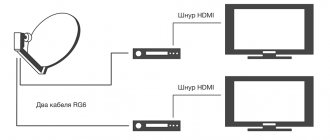The first issue on the agenda is about readiness for the transition to the digital format of television broadcasting.
Opening remarks by Dmitry Medvedev
Report by Konstantin Noskov on the transition to the digital format of television broadcasting
Message from the Governor of the Tver Region Igor Rudeni
Briefing by Konstantin Noskov and General Director of the Federal State Unitary Enterprise "Russian Television and Radio Broadcasting Network" Andrey Romanchenko at the end of the meeting
From the transcript:
The figure is sweeping the country
For some time in Russia there was a project within the framework of which it was assumed that domestic digital broadcasting would immediately be conducted in the HDTV format.
Note that at that time (2005) there was no HD broadcasting as such in Russia. Nevertheless, forecasts said that within five years, half of Russian viewers would have televisions with the ability to receive a digital signal, and by 2016 - 85%, which would make it possible to switch off the analogue signal most painlessly. Interestingly, these predictions actually came true. Except that the Russian viewer receives an HD signal from anywhere, but not from the air, and for on-air broadcasting, HDTV still remains a prospect. But these are already details. Then, various concepts for the development of television and radio broadcasting in the Russian Federation were repeatedly published, until finally, in September 2009, the final version was signed. True, as it turned out, it did not turn out to be unchanged and contained many surprises for all interested parties. As the concept was discussed, everything that related to distribution networks, that is, those networks (primarily satellite) through which the signal was delivered to local RTPCs, actually dropped out of it. This (extremely important at first) task was completed without much fuss and was completely lost against the background of the ever-increasing intensity of passions around the project of digitalization of all broadcasting in general.
And then came the period of implementation. Over the subsequent years, RTRS regularly reported on the growing percentage of coverage of Russian viewers, first by the first and then by the second multiplex. And interested players discussed the upcoming changes. The focus of interest has moved from the technical area to the content area: who will get to the first multiplex? Who's in the second? How will the entire television market in Russia change in general? Regional companies, anticipating the imminent end of the usual pattern of interaction with federal partners, periodically sounded the alarm, threatening the collapse of the regional market (here, by the way, the picture has not changed).
By 2015, as originally planned, they did not have time to carry out digitalization, maybe it was for the best, since haste in such projects does not lead to anything good. However, they solved the most urgent task on time - they launched digital broadcasting in the border areas. Since by decision of the ITU, since 2015, all analogue stations have lost frequency protection, the issue of cross-border broadcasting had to be resolved on time. Otherwise, international regulators could require the shutdown of any analogue television transmitter that would interfere with any services in neighboring countries. To do this, 283 transmitters in 27 regions had to be converted to digital.
The management was openly afraid to turn off the analogue throughout the country, which, in general, is understandable. Any interruptions in broadcasting (we do not forget that for residents of many regions, TV is still the main channel of information and a significant social factor) could (and did) cause social explosions. A balanced approach and active explanatory work were required.
As the project progressed, this is where slowness played a positive role! - changed the technical concept. The transition to DVB-T2 affected several hundred advanced viewers from Moscow, who bought televisions with the ability to watch DVB-T and found themselves with nothing. However, against the backdrop of the entire Russian television community, this went almost unnoticed.
We approached 2021 with a clear understanding that it will be the last year of the existence of analogue broadcasting in Russia. True, it was not very clear: what would happen to the second multiplex in the end? Its coverage did not reach 70%, and TV channels were not eager to pay for its broadcast in cities with a population of less than 100 thousand people. Initially, the state planned to stop subsidizing the distribution of TV channels in cities with a population of less than 100 thousand people in mid-January 2021, which will consist of the so-called “analogue shutdown.” But in November 2021, the government decided that the transition to digital should take place smoothly and gradually over six months - from February 11 to June 10, 2021. According to the target indicators specified in the program “Development of Television and Radio Broadcasting in the Russian Federation for 2009-2018”, the share of the country’s population with the ability to receive 20 digital public television channels (that is, two multiplexes) should be 98.1% (the numbers will change slightly).
In September, a statement was made by Deputy Minister of Digital Development, Communications and Mass Communications Alexey Volin that the full activation of the second multiplex throughout Russia is planned for December 2021, despite the fact that at that time all twenty channels of the two multiplexes were available on air 65% residents of the Russian Federation.
A little later, RTRS Deputy General Director Viktor Pinchuk announced that the second multiplex would be launched in November. “Due to the vast geography of our country, it will not be possible to launch the second multiplex at all facilities simultaneously, so the launch will begin in November, and all transmitters will be operational in December,” the RTRS press service clarified to Telesputnik.
“Several thousand broadcasting points have been built and are waiting to be turned on to broadcast the second multiplex. At the moment, coverage is about 68% of the population, and the final coverage of residents by the second multiplex will not be lower than the values specified in the federal target program “Development of television and radio broadcasting in the Russian Federation for 2009-2018,” RTRS also said.
Direction prospects
Today, digital broadcasting covers 100% of the country's territory. “20 channels and 3 radio stations in excellent digital quality are available to Russians. I believe that the implementation of this project is a good example of the transition to digital rails of an entire sector of our economy. We are now actively participating in the Digital Economy program. Using our infrastructure, they plan to connect 100 thousand different social facilities: first aid stations, police stations, hospitals, schools,” noted Andrey Romanchenko.
In the meantime, Russians can evaluate and enjoy the quality of the clearer picture that digital will give them.
Percents and billions
The entire infrastructure consists of 5028 communication objects. 20 TV channels and three radio channels are distributed. Coverage is 98.4% of the Russian population.
The network of the first multiplex operates in 85 regions of the country (5021 objects) with coverage from 95% to 100%. The network of the second multiplex includes 4,758 objects, and 29 still need to be launched by the end of the year. Coverage - 97.84%.
Interesting figures were given by Victor Pinchuk. The digitalization process took 9 years in Russia. A lot of? Quite a lot. However, for such a powerful infrastructure project it is quite normal. In the USA this process lasted 11 years, and in the UK 14 years. The cost of the program was 1,582 rubles per household. Note that this does not take into account the funds that each viewer must spend on a set-top box or a new TV. In the UK these costs amounted to €135, in Spain €65.
The program budget amounted to 63.4 billion rubles, of which 43 billion rubles were federal funds. Today, 18 million digital set-top boxes have been sold to the population, and this does not take into account the so-called gray market. 70 million televisions with the ability to receive DVB-T2 have been sold. In total, according to the Ministry of Telecom and Mass Communications, 5 million households do not have the technical ability (that is, equipment for reception) to receive a digital signal. This amounts to about 10% of all Russian households, and this number is estimated as acceptable for turning off the analogue (we remember that at the dawn of the program the figure was 85%).
The state will spend 30 billion rubles. for the last months of analogue broadcasting
Deputy Minister of Communications Alexey Volin says that the extension of analogue broadcasting of federal channels until mid-2019 will cost the state budget 30 billion rubles. This is the amount of subsidies for broadcasting in cities with a population of less than 100 thousand people.
At the same time, the state invested 80 billion rubles in the infrastructure of digital terrestrial television broadcasting, which should replace analogue broadcasting. Now, according to Volin, only 10% of households are not able to receive a digital TV signal.
What about the third multiplex?
It is important for regionals who do not understand what awaits them in the future. And the FAS perceives the absence of a third multiplex as a limitation of competition.
The principled position of the Ministry of Telecom and Mass Communications is that the issue of a third multiplex can be considered only after the first two are fully operational. And until then, the ministry will not talk about the third multiplex.
What does it mean to “earn their full potential”? First of all, they will succeed economically and will work for at least a year. Development is proceeding in stages, and the first stage, upon completion of which it will be possible to at least think about further development, is called “expansion of the second multiplex throughout the entire territory of the Russian Federation.” And the TV channels themselves must evaluate, so to speak, their economic well-being, since they bear all the costs of maintaining the second multiplex. For TV channels included in the second multiplex, broadcasting costs increase fivefold. And the ministry wants to make sure that they get through this stage without any major shocks. Alexey Volin believes that the failure of the second multiplex could bury a significant part of all Russian television under its rubble. And therefore, until this stage is completed, the ministry is not inclined to allow experiments with the industry.
What if the second multiplex fails? Is there a scenario for this scenario? Then, according to Alexey Volin, it is necessary to live outside of digital broadcasting, develop cable, mobile TV, IPTV, and alternative delivery methods. But it would be better if the second multiplex justified itself.
In principle, the composition of the second multiplex is determined by competition. This is not the first multiplex where channels have been assigned by presidential decree. If the channel of the second multiplex refuses it (for example, due to a heavy financial burden), then its replacement is determined by competition. But it is unlikely that there will be such people willing, since it is unlikely that any channel will refuse such an advantageous position as must carry.
Russia says goodbye to analogue television broadcasting
The Government Commission on Television and Radio Broadcasting has approved a schedule for switching off analog television broadcasting of federal television channels in Russia. The schedule was published by the Ministry of Digital Development, Communications and Mass Media.
Previously, the government decided to carry out a phased shutdown of analogue broadcasting of federal channels in Russia from the beginning of 2021. One Russian region has already completely abandoned analogue broadcasting and switched to a digital signal: this is the Tver region.
Further shutdown of analogue TV will be carried out in three stages. Some regions will be disconnected from analogue broadcasting of federal channels on February 11, 2021, another part on April 15, and the remaining on June 3. After these dates, television viewers in the relevant regions will see an information message on the screen about the transition from analogue to digital television.
It follows from the schedule published by the Ministry of Telecom and Mass Communications that at the first stage, only seven regions, including Chechnya, will be disconnected from analogue broadcasting of federal channels. At the second stage, another 20 regions, including Moscow and the region, will be disconnected from analogue broadcasting of federal channels.
By June 2021, analogue broadcasting of federal TV channels will be completely switched off in Russia
Finally, at the third stage, the remaining 57 regions will be disconnected from analogue broadcasting of federal channels, including St. Petersburg, the Leningrad region, the Republic of Crimea and Sevastopol.
So far we are only talking about turning off analogue broadcasting of federal channels included in the first and second multiplexes of digital terrestrial TV. Regional channels will continue broadcasting in analogue format.
Regional channels remain in analog signal
Executive Director of the National Association of Television and Radio Broadcasters (NAT), Alexander Shirokikh, believes that it is correct that analogue broadcasting will be switched off gradually. “At the same time, it’s unexpected that the channels of both multiplexes will be switched off all over the country at once,” says Shirokikh. “Previously, it was planned to turn off only the channels of the first multiplex, and only in cities with a population of less than 100 thousand.”
“For regional TV channels, the proposed schedule is rather worse than the original paradigm,” continues the executive director of NAT. “The TV viewer is unlikely to remain in analogue mode just for the sake of regional channels.” For regional TV channels, permissions to use frequencies issued by Roskomnadzor expire on August 19, 2021. NAT will push for their renewal.
How Russia switched to digital TV
Let us recall that in 2009, Russia approved the Federal Target Program (FTP) for the development of television and radio broadcasting until 2015 (later its validity was extended until 2021). It involved the transition of TV broadcasting to a digital signal. It was planned that three multiplexes (packages) of digital channels would be deployed throughout the country, and in large cities additionally the fourth and fifth multiplexes, as well as high definition (HDTV) and mobile TV.
Schedule for switching off analogue television broadcasting by regions of Russia
| Stage | Date of termination of analogue broadcasting of compulsory public television channels (with the exception of compulsory public television channels of the constituent entities of the Russian Federation) | Federal District | The subject of the Russian Federation | |
| 1 | 0 | December 03, 2021 | Central Federal District | Tver region |
| 2 | I | February 11, 2021 | Far Eastern Federal District | Magadan Region |
| 3 | I | February 11, 2021 | Volga Federal District | Penza region |
| 4 | I | February 11, 2021 | Central Federal District | Ryazan Oblast |
| 5 | I | February 11, 2021 | Central Federal District | Tula region |
| 6 | I | February 11, 2021 | Volga Federal District | Ulyanovsk region |
| 7 | I | February II, 2021 | North Caucasian Federal District | Chechen Republic |
| 8 | I | February II, 2021 | Central Federal District | Yaroslavl region |
| 9 | II | April 15, 2021 | Far Eastern Federal District | Amur region |
| 10 | II | April 15, 2021 | Central Federal District | Ivanovo region |
| 11 | II | April 15, 2021 | North Caucasian Federal District | Kabardino-Balkarian Republic |
| 12 | II | April 15, 2021 | North Caucasian Federal District | Karachay-Cherkess Republic |
| 13 | II | April 15, 2021 | Siberian Federal District | Kemerovo region |
| 14 | II | April 15, 2021 | Volga Federal District | Kirov region |
| 15 | II | April 15, 2021 | Central Federal District | Kostroma region |
| 16 | II | April 15, 2021 | Ural Federal District | Kurgan region |
| 17 | II | April 15, 2021 | Central Federal District | Lipetsk region |
| 18 | II | April 15, 2021 | Central Federal District | Moscow |
| 19 | II | April 15, 2021 | Central Federal District | Moscow region |
| 20 | II | April 15, 2021 | Northwestern Federal District | Novgorod region |
| 21 | II | April 15, 2021 | Southern Federal District | Republic of Kalmykia |
| 22 | II | April 15, 2021 | Volga Federal District | The Republic of Mordovia |
| 23 | II | April 15, 2021 | Far Eastern Federal District | Sakhalin region |
| 24 | II | April 15, 2021 | North Caucasian Federal District | Stavropol region |
| 25 | II | April 15, 2021 | Ural Federal District | Tyumen region |
| 26 | II | April 15, 2021 | Volga Federal District | Udmurt republic |
| 27 | II | April 15, 2021 | Volga Federal District | Chuvash Republic |
| 28 | II | April 15, 2021 | Ural Federal District | Yamalo-Nenets Autonomous Okrug |
| 29 | III | June 03, 2021 | Siberian Federal District | Altai region |
| 30 | III | June 03, 2021 | Northwestern Federal District | Arhangelsk region |
| 31 | III | June 03, 2021 | Southern Federal District | Astrakhan region |
| 32 | III | June 03, 2021 | Central Federal District | Belgorod region |
| 33 | III | June 03, 2021 | Central Federal District | Bryansk region |
| 34 | III | June 03, 2021 | Central Federal District | Vladimir region |
| 35 | III | June 03, 2021 | Southern Federal District | Volgograd region |
| 36 | III | June 03, 2021 | Northwestern Federal District | Vologda Region |
| 37 | III | June 03, 2021 | Central Federal District | Voronezh region |
| 38 | III | June 03, 2021 | Northwestern Federal District | Saint Petersburg |
| 39 | III | June 03, 2021 | Far Eastern Federal District | Jewish Autonomous Region |
| 40 | III | June 03, 2021 | Far Eastern Federal District | Transbaikal region |
| 41 | III | June 03, 2021 | Siberian Federal District | Irkutsk region |
| 42 | III | June 03, 2021 | Northwestern Federal District | Kaliningrad region |
| 43 | III | June 03, 2021 | Central Federal District | Kaluga region |
| 44 | III | June 03, 2021 | FEFD | Kamchatka Krai |
| 45 | III | June 03, 2021 | Southern Federal District | Krasnodar region |
| 46 | III | June 03, 2021 | Siberian Federal District | Krasnoyarsk region |
| 47 | III | June 03, 2021 | Central Federal District | Kursk region |
| 48 | III | June 03, 2021 | Northwestern Federal District | Leningrad region |
| 49 | III | June 03, 2021 | Northwestern Federal District | Murmansk region |
| 50 | III | June 03, 2021 | Northwestern Federal District | Nenets Autonomous Okrug |
| 51 | III | June 03, 2021 | Volga Federal District | Nizhny Novgorod Region |
| 52 | III | June 03, 2021 | Siberian Federal District | Novosibirsk region |
| 53 | III | June 03, 2021 | Siberian Federal District | Omsk region |
| 54 | III | June 03, 2021 | Volga Federal District | Orenburg region |
| 55 | III | June 03, 2021 | Central Federal District | Oryol Region |
| 56 | III | June 03, 2021 | Volga Federal District | Perm region |
| 57 | III | June 03, 2021 | Far Eastern Federal District | Primorsky Krai |
| 58 | III | June 03, 2021 | Northwestern Federal District | Pskov region |
| 59 | III | June 03, 2021 | Southern Federal District | Republic of Adygea |
| 60 | III | June 03, 2021 | Siberian Federal District | Altai Republic |
| 61 | III | June 03, 2021 | Volga Federal District | Republic of Bashkortostan |
| 62 | III | June 03, 2021 | Far Eastern Federal District | The Republic of Buryatia |
| 63 | III | June 03, 2021 | North Caucasian Federal District | The Republic of Dagestan |
| 64 | III | June 03, 2021 | North Caucasian Federal District | The Republic of Ingushetia |
| 65 | III | June 03, 2021 | Northwestern Federal District | Republic of Karelia |
| 66 | III | June 03, 2021 | Northwestern Federal District | Komi Republic |
| 63 | III | June 03, 2021 | Southern Federal District | Republic of Crimea |
| 64 | III | June 03, 2021 | Volga Federal District | Mari El Republic |
| 66 | III | June 03, 2021 | Far Eastern Federal District | The Republic of Sakha (Yakutia) |
| 67 | III | June 03, 2021 | North Caucasian Federal District | Republic of North Ossetia-Alania |
| 68 | III | June 03, 2021 | Volga Federal District | Republic of Tatarstan |
| 69 | III | June 03, 2021 | Siberian Federal District | Tyva Republic |
| 70 | III | June 03, 2021 | Siberian Federal District | The Republic of Khakassia |
| 71 | III | June 03, 2021 | Southern Federal District | Rostov region |
| 72 | III | June 03, 2021 | Volga Federal District | Samara Region |
| 73 | III | June 03, 2021 | Volga Federal District | Saratov region |
| 74 | III | June 03, 2021 | Ural Federal District | Sverdlovsk region |
| 75 | III | June 03, 2021 | Southern Federal District | Sevastopol |
| 76 | III | June 03, 2021 | Central Federal District | Smolensk region |
| 78 | III | June 03, 2021 | Central Federal District | Tambov Region |
| 80 | III | June 03, 2021 | Siberian Federal District | Tomsk region |
| 81 | III | June 03, 2021 | Far Eastern Federal District | Khabarovsk region |
| 82 | III | June 03, 2021 | Ural Federal District | Khanty-Mansiysk Autonomous Okrug |
| 84 | III | June 03, 2021 | Ural Federal District | Chelyabinsk region |
| 85 | III | June 03, 2021 | Far Eastern Federal District | Chukotka Autonomous Okrug |
Source CNews Analytics
The composition of the first multiplex was determined by decree of the President of Russia. Now it includes 10 channels: “Channel One”, “Russia 1”, “Match TV”, NTV, “Channel 5”, “Russia K”, “Russia 24”, “Carousel”, “Public Russian Television” and TVC .
OSDU: what you need to know about open standards for working with data in oil and gas
New in storage
Their reception in digital format is ensured almost throughout the entire territory of Russia. Initially, the must carry principle was introduced by law in relation to these TV channels: operators of all types of TV broadcasting are obliged to broadcast them free of charge - both for subscribers and for the channels themselves.
In addition, in 2009, the state decided to subsidize broadcasting of these channels, both digital and analogue, in all settlements with a population of less than 100 thousand people. Then it was decided to send subsidies directly to the terrestrial TV operator - the Russian Television and Radio Broadcasting Network (RTRS). Moreover, in this way the state decided to pay for the broadcasting of these channels throughout the country: both in analogue and digital format.
This procedure continues to apply only until the end of 2021. From 2019, the state will again provide subsidies to the channels themselves only for broadcasting in digital and analogue environments in cities with a population of less than 100 thousand.











